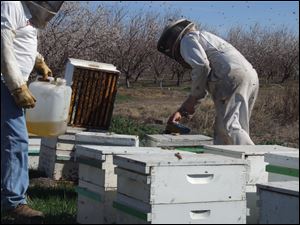
Insects stir early after winter of warmth
3/12/2012
Large hives of domesticated bees often respond to food shortages by slowing egg production, which means there will be fewer bees to build honey stores for the next winter.
WASHINGTON — The eerily warm winter across the nation might soon get creepy.
Awakened from hibernation underground, in rotting wood, and the cracks of houses, bugs are on the rise.
Ants, termites, mosquitoes, ladybugs, and ticks are awake early and looking for breakfast.
Pest-control company Orkin said recently that agents nationwide are reporting a 30 percent increase in calls to treat ant infestations compared with this time last year.
Termite swarms do not normally show up until the end of March, but Orkin received 85 termite-control calls in February.
An Orkin branch in Maryland already responded to mosquito sightings this year.
And the National Pest Management Association issued an early warning of ticks, possibly carrying Lyme disease, lurking in back yards.
County agricultural extension agents across the country are sending out bug alerts to farmers.
“These things are cold-blooded,” said Mike Raupp, a professor of entomology at the University of Maryland. “Whenever we have a warm winter, they’re going to be out earlier. How do you stop them? You pray for cold weather.”
A mild winter is not great for all bugs, including some highly beneficial insects.
Some were up and about when they should have been idle and hibernating, burning less energy, experts say. When this happens, they gobble the food they stored for the winter and emerge into a world where food is scarce. Many starve.
Honeybees are a perfect example. Beekeepers say the insect was probably more active this winter, one of the warmest on record.
Several beekeepers said they put sugar water or water mixed with syrup near their hives, worried that queens became active in warm weather and started pumping out thousands of eggs a day.
The situation is more dire because, in much of the country, there was little snow and rain this winter. That means spring flowers may not produce the quantities of nectar needed to feed the workers and the young and colonies will be more dependent on depleted stores of honey, pollen, and water.
Weather-related stresses make a bad situation worse. Hives of 40,000 to 60,000 domesticated bees often respond to food shortages by slowing egg production, said Brian Royal, owner of Royal Bee Supply in Norman, Okla. That means there will be fewer bees to build honey stores for the next winter.
“It’s a domino effect,” Mr. Royal said of the damage that can done by a winter during which it “seems like everything is running a month ahead of schedule.”
The National Oceanic and Atmospheric Administration reported last month that “warmer-than-average temperatures were widespread across the 48 contiguous states during January.”
For farmers, pesticide costs can become terribly expensive, Mr. Raupp said, “if you have aphids or spider mites cranking through extra generations. For pests with faster generation times, the hotter it is the more they develop.”
Aphids and psyllids, also called plant lice, are among the pests that plague farmers.
In urban areas,a homeowner who spots termites has a problem.
“If you notice termites in your house, you’re only going to notice [them] if there’s a swarm,” said Greg Baumann, vice president of training and technical services at Orkin.
Insects have the upper hand when it comes to survival of the species. “Always bet on the bug. They’ve been around for millions of years,” Mr. Baumann said.